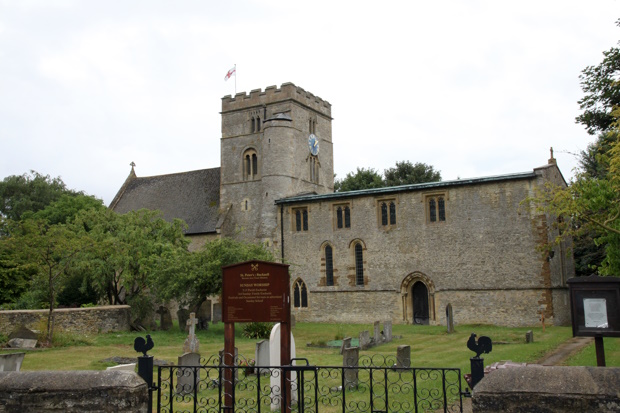


























St. Peter's Church, Bucknell
St. Peter's Church in Bucknell is a stone building comprising a chancel, clerestoried nave, south porch, and central tower. It is a fine example of 13th-century architecture, but the massive tower, placed between chancel and nave, is 12th century and belongs to an earlier church; another story with windows and battlements was added in the 15th century. The tower stands on plain Romanesque arches; the north and south ones have filled-in arches with small 12th-century windows under them, but the eastern arch was rebuilt in the 14th century. On the north side of the tower there is a 12th-century stair turret, and on the south side a door leading into the Victorian vestry. The chancel, which is exceptionally long (35 ft. by 19 ft.), is a fine specimen of early-13th-century work. At the east end there are three lancet windows with elegant shafts and deeply cut arch mouldings. On the north and south sides are lancet windows and two low windows, lancet outside and square-headed inside. In the north wall of the chancel is a blocked doorway and (externally) the piscina of a vanished vestry; the barrel roof of wood was formerly (1846) concealed by plaster. The 13th-century nave has a lancet window at the west end, with shafts and moulded rear-arch. The striking south door is carved with unusual mouldings, and supported by clustered shafts; the northern door is also of early-13th-century workmanship. On the south side of the nave there is a 13th-century holy-water stoup, and there are the remains of a piscina and altar at the north-east corner of the nave. The absence of aisles is singular, and it is possible that the blocked arches on the north and south sides of the nave were intended to open into the transepts. The nave roof and a clerestory with square-headed two-light windows were added in the 15th century. The flat plastered ceiling which concealed the roof in the 19th century has been removed. The church, a has preserved its distinctive medieval character, in spite of later alterations. It was ordered to be painted in 1633; was beautified in 1706; was again ordered to be repaired in 1757; and in 1829 the old seats were replaced by high deal pews and a western gallery was built, both of which have since been removed. In 1855 the parish spent £50 on repairing the inside of the church, and in the following year the rector spent £220 on repairing and partially rebuilding the chancel walls. More thorough restoration was undertaken in 1893. The nave was refloored and a new oak roof was inserted; the top story of the tower was rebuilt; a new arch put in the south porch; new choir seats were installed in the chancel and a vestry and a heating system were added, at a total cost of £740. In 1955 the church retained its 19th-century oil lamps. There is a plain octagonal font on an octagonal base of two tiers, and a fine pulpit of carved oak, probably of Jacobean date. The organ is early 19th-century. An oak altar table was given in 1872. In the chancel there is a brass tablet to Edward Ewer (d. 1638) and Margaret Poure his wife, daughter of Francis Poure of Bletchingdon, and another to their eldest son Francis Ewer. There are also a number of memorial slabs on the chancel floor, now mostly indecipherable or partially concealed under pews. Rawlinson mentions memorials to William Rawlinson (d. 1643); Richard Bennett, rector (d. 1591/2); John Gardner, rector (d. 1670); John Coxed, rector (d. 1709) and others to his family. In the nave there are a number of well-carved marble monuments to the Trotman family; to Samuel Trotman (d. 1684/5) and Mary his wife (d. 1667); to Lenthall Trotman (d. 1709/10); to Samuel Trotman (d. 1719/20); to another Samuel Trotman (d. 1748/9); to Thomas Trotman (d. 1751) and his son Samuel (d. 1775); and a modern brass to Lt.Col. Frederick Drummond Hibbert (d. 1897) and his wife (née Trotman). The armorial glass in the chancel mentioned by Wood has disappeared, as have also the windows containing figures and inscriptions to the Larwoldes, the Freemans, and to Robert and Thomas Clement and their wives. Historical information about St. Peter's Church is provided by British History Online. 'Parishes: Bucknell', in A History of the County of Oxford: Volume 6, ed. Mary D Lobel (London, 1959), pp. 71-80. British History Online http://www.british-history.ac.uk/vch/oxon/vol6/pp71-80 [accessed 13 January 2023]. St Peter's Church is a Grade I listed building. For more information about the listing see CHURCH OF ST PETER, Bucknell - 1200258 | Historic England. For more information about St. Mary's Church see Parishes: Bucknell | British History Online (british-history.ac.uk). |

